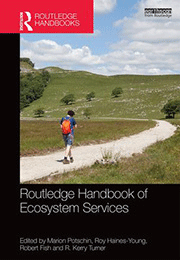My review copy of the Routledge Handbook of Ecosystem Services landed on the doormat with quite a loud bump! At 630 pages, it is a Handbook for people with big hands.
It is a weighty tome too. This is not merely in terms of its mass (a fraction over 1.3kg) but in the range and depth of topics pertaining to ecosystem services that are covered, and the globally renowned authors who have contributed. Following a foreword by Bob Watson and an opening chapter by Bob Costanza, the Handbook is broken into four major sections addressing ecosystem services from the perspectives of: concepts and frameworks; methods and techniques for decision support; applied contexts; and linking and informing agendas. Across this broad categorisation is a diversity of chapters ranging from the defining and of measuring ecosystem services through to ecosystem structures and processes, from valuation concepts and methods through to indicators, from stakeholder participation in decision-making to the roles of ecosystem services in contexts, from food security and health to urban and natural settings. Between the historical emergence of the concept and its application in contexts from business to forest management and urban design, ecosystem services are addressed in theoretical and applied contexts. Detailed discussion of these and many more diverse ecosystem service-related topics are helpfully supported by numerous case studies and boxes outlining important concepts, with various ‘killer facts’ thrown into the mix. (For example, we are losing $500 billion annually in foregone benefits from declining ecosystem services, and the difficulties encountered in translating what we know about ecosystem services into mainstream practice is thwarted by the fact that the costs of disservices are far easier to measure than the value of many services.)
Each of the chapters mines the now voluminous and growing literature around its selected topic. This alone is a valuable resource for students, scholars and those seeking to implement ecosystem services.
An aspect of this volume that I found particularly enlightening was its avoidance of the didactic. Instead, it circumscribes the emerging ‘state of the art’ of our knowledge and practice about ecosystem services, asking us many questions as presenting answers. Indeed, concluding the introductory chapters to each of the Handbook’s four main sections are lists of ‘Key discussion and debating points’.
 Care is taken to present what is known, but also to open rather than to close debate. As one example, various ecosystem service classifications are presented, but also the honest and open perspective that all such frameworks simplify the interactions between people and nature need to be regarded as limited, but are useful for bringing people from different disciplines together, rather than representing “…some kind of ‘standard lexicon’” (page 125) unifying all perspectives. As Bob Costanza notes up front, the generally accepted standard Millennium Ecosystem Assessment definition of ecosystem services, “…the benefits people obtain from ecosystems”, is “…an appropriately broad and an appropriately vague definition” (page 17), and is perhaps more valuable in its capacity to promote creative cross-sectoral dialogue and innovation than in providing definitive answers.
Care is taken to present what is known, but also to open rather than to close debate. As one example, various ecosystem service classifications are presented, but also the honest and open perspective that all such frameworks simplify the interactions between people and nature need to be regarded as limited, but are useful for bringing people from different disciplines together, rather than representing “…some kind of ‘standard lexicon’” (page 125) unifying all perspectives. As Bob Costanza notes up front, the generally accepted standard Millennium Ecosystem Assessment definition of ecosystem services, “…the benefits people obtain from ecosystems”, is “…an appropriately broad and an appropriately vague definition” (page 17), and is perhaps more valuable in its capacity to promote creative cross-sectoral dialogue and innovation than in providing definitive answers.
The concluding chapter of the Handbook describes ecosystem services as “…confronting questions about our relationship to nature in the modern world” but that, at the present time, “…the paradigm of ecosystem services remains a ‘work in progress’” (page 609). Reading through the diversity of topics addressed throughout the substantial volume, this much is evident but so too is the weight of robust and paradigm-challenging science and examples of informed practice already in place.
So, who would benefit from reading this book or, more pointedly, how should it be read? I think I will be in the minority for reading it cover-to-cover. But, students, researchers and those seeking to grasp and implement the emerging, integrative concept of ecosystem services will benefit from dipping into it as a reference book to glean current thinking, areas of debate and practical illustrations. Not one for the holiday Kindle then, but it is more than useful to know where a copy of the Handbook can be found when seeking current thinking and guidance for those challenging papers, essays and decisions.
The Routledge Handbook of Ecosystem Services
Marion Potschin, Roy Haines-Young, Robert Fish, R. Kerry Turner (editors) | ISBN: 978-1-138-02508 | Published: January 2016 | Publisher: Routledge





